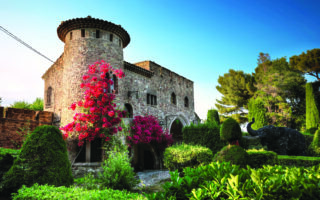A tour of Tarn-et-Garonne
Mary Novakovich heads for the rich and fertile department of Tarn-et-Garonne and discovers that it’s as beautiful as it is bountiful
It’s one of France’s smaller departments but Tarn-et-Garonne squeezes in a wealth of diversity – historical, cultural and geographical – within its 3,718km². Its tumultuous history during the Wars of Religion and Hundred Years War left many marks on the landscape, the most beautiful of which are bastide villages – the new towns of the Middle Ages. The Gorges de l’Aveyron provide a dramatic border to the east, their thickly forested cliffs contrasting vividly with the stark limestone hills of the Causses de Quercy to the north.
The two rivers that give the department its name meander through the valleys and plains of some of the most fertile land in the country. The area certainly qualifies as the fruit bowl of France: countless orchards fill vast tracts of land, yielding apples, peaches, cherries and plums as well as juicy Quercy melons. Cèpes, morilles and truffles hide in the forests, while small-scale producers add their duck and goose products to the region’s bulging larder of ewe’s milk, goat’s cheese and prized lamb from the Causses de Quercy. Indeed, it’s hard not to feel your appetite build as you drive past signs advertising artisanal cheeses and produce for sale.
Montauban, the capital and largest town, gives off the unmistakable air of being in the mellow south-west of France. It rivals its southern neighbour, Toulouse, in the predominantly rosy tone of its brick buildings that herald the town’s roots in the Middle Ages. The Place Nationale is its medieval heart, with its double arcade ringing the square, topped with graceful pink brick townhouses. Founded in 1144, the town predates the construction of the bastides that were built all around the south-west in the 13th and 14th centuries to entice people to what had been a virtually empty landscape. It has the same architectural principles, though, with the arcaded square surrounded by grids of narrow pedestrianised streets filled with shops, cafés and strolling Montalbanais.
By the eastern bank of the River Tarn is the enormous 17th-century bishops’ palace that has since been turned into a museum celebrating the town’s two most famous artistic sons. The painter Jean-Auguste-Dominque Ingres and the sculptor Emile-Antoine Bourdelle have their works displayed in this impressive building, and there’s an extra treat in store underground where England’s Black Prince created a fascinating vaulted chamber in the 14th century.
Montauban’s rich and sometimes complex history encompasses its former role as a Protestant stronghold as well as its return to Catholicism in the 17th century. The old Jesuits’ College, housed in an imposing pink brick townhouse, is now home to the tourist office where interactive displays recount how dramatic events over the centuries have shaped the town. It’s also one of places to pick up a ‘beecycle’, one of Montauban’s yellow bikes for hire, and explore the town at a leisurely pace along the River Tarn or the Canal de Montech.
Follow the Tarn further west and you reach an important stop on the Route de Santiago de Compostela. Moissac has been welcoming pilgrims for a millennium, drawn to the splendour of the abbey of St-Pierre. This UNESCO World Heritage Site is a superb example of Romanesque architecture, and the abbey’s cloisters are a tranquil place to stop and marvel at the intricate work of those unknown 12th-century craftsmen.
Both man and nature had a hand in Moissac’s waterside life, where the Tarn is crossed by the Canal des Deux-Mers. Trees flank the Bassin du Tarn, where pleasure boats make their lazy way past the two river islands. Along the canal, cyclists and walkers enjoy the peace and beauty of the towpath that can take them all the way to the Mediterranean or back towards the Atlantic. In the summer, the banks of the Tarn are transformed into Moissac Plage, where locals cool off on the man-made beach.
One of Moissac’s chief culinary offerings is the Chasselas grape, the first fresh fruit in France to receive its own appellation d’origine contrôlée. Cultivators are scattered throughout this western part of Tarn-et-Garonne, most of whom open their doors to visitors eager to taste the sweet dessert grape and have a wander among the vines. Ask at the tourist office, which is by the entrance cloisters, for its list of producers and restaurateurs who offer tastings.
A few kilometres west of Moissac is the confluence of the rivers Tarn and Garonne, where, if you veer south-west along the Garonne, you soon reach one of the three Plus Beaux Villages de France in the department. Gallo-Roman Auvillar, which is also a stop along the Route de Santiago de Compostela, deserves its place in the list of the country’s most beautiful villages. It’s an enchanting little place, where a medieval arcaded square of half-timbered houses clusters around a 19th-century circular corn exchange, site of a Sunday morning farmers’ market. Street names give a clue about life in previous centuries: Rue des Nobles, Rue du Palais, Place du Château. The château was destroyed in the 16th century; its space now a park and lookout point over the Garonne and the valley below.
A small museum by Place de la Halle tells the story of Auvillar’s time as an important centre for ceramics from the 17th to the 19th centuries. At its height, nearly 400 potters were crafting delicate earthenware pieces, some of which are displayed in the museum. The same ticket gets you into the Musée de la Batellerie in the 17th-century clock tower at the entrance to the ancient village centre. The permanent collection recalls the 19th-century heyday of river traffic in the village, when some 3,000 boats would pass every year.
Cross the Garonne towards Valence d’Agen, a bastide anglaise created by England’s Edward I in 1283. The large covered market in the arcaded Place Nationale is the scene of one of the area’s liveliest markets, when several hundred stallholders descend every Tuesday morning to sell their local produce. The same square hosts a large farmers’ market every Saturday. Head down towards the Canal des Deux-Mers to find the town’s pretty terracotta-roofed lavoirs, wash houses, dating from the 18th and 19th centuries.
The long-travelled Route de Santiago de Compostela winds through the rolling limestone hills of the old province of Quercy Blanc, where you can see some of the 3,000 or so pigeonniers, or dovecotes, that characterise the landscape of the department. To the north is Lauzerte, a favourite stop among pilgrims and secular visitors alike. Another worthy member of the Plus Beaux Villages de France, this medieval hilltop bastide is a delight to explore. Stone and half-timbered houses form the main arcaded square, La Place des Cornières, at the top of the village. Just in front of the square’s 13th-century St-Barthélemy church, the corner of the paving has been turned upwards to reveal a colourful mosaic – for no reason other than sheer whimsy. You can find other charming quirks as you wander the flower-filled cobbled lanes: an iron figurine of a medieval monk perched high on a chair, for example.
A stroll through the pilgrims’ garden, the Jardin du Pèlerin, takes you gently down towards the lower village, offering serene views of terracotta rooftops and the Quercy countryside along the way. If you find yourself there on a Saturday morning, don’t miss the vibrant market in the Place des Cornières.
The eastern side of Tarn-et-Garonne is just as rich in history, and the landscapes shift from rolling hills to the spectacular Gorges de l’Aveyron. The department’s third Plus Beaux Villages de France, Bruniquel, holds a commanding position over the River Aveyron. Somehow defying the forces of gravity, its two medieval châteaux cling to the edge of the cliff overlooking the river. Bruniquel is a stop on the Route de Santiago de Compostela, although what some of the more pious pilgrims would have thought of some of the street names – Rue Bombecul (Thrust-Out Bottom Street), Rue Trotte-Garces (Trotting Tarts Street) – is anybody’s guess.
The village’s jumble of cobbled lanes takes ‘higgledy-piggledy’ to a new level. For such a small place, it’s remarkably easy to get lost among the picturesque stone and half-timbered houses that tumble down from the château to the 17th-century church at the bottom of the village. Most of the houses are in a warm, dark honey-coloured stone, some with mini turrets, others connected via stone archways. Tucked in a tiny square is the 13th-century Maison Payrol, at various points in its history a Cistercian monastery, a governor’s house and now an exhibition space with changing exhibits as well as a permanent display of objects from the Middle Ages.
To drive from Bruniquel to one of the area’s most appealing villages, St-Antonin-Noble-Val, you have to take a detour into the neighbouring Tarn department along the winding road that shadows the Aveyron. Soon you’re back in Tarn-et-Garonne and crossing the flower-covered bridge over the Aveyron and into St-Antonin. Inexplicably it’s not one of the Plus Beaux Villages de France but it should be. Since the eighth century, when a Benedictine monastery was built here, the village has been attracting people to this sheltered ‘noble valley’ under the limestone Roc d’Anglars and Roc Deymié.
A stroll along its atmospheric streets reveals fascinating snippets of history – from a 14th-century former tannery to the last communal bread oven. There’s even a Rue Bombecul here too. France’s oldest civil building, an exquisite stone creation dating from 1125, is now a museum. It adds to the ageless beauty of the half-timbered houses in Place de la Halle, where the 1841 covered market hall is a veritable newcomer in comparison. Sunday morning is the time to see the market in full flow.
St-Antonin-Noble-Val is also a major centre for outdoor activities, thanks to the river and the Gorges de l’Aveyron. Climbers, cavers, hikers and cyclists delve into the gorges, while canoeists and kayakers paddle along the clear waters of the Aveyron. Or you can take things at a slower pace and go for relaxing walks along the river – not surprisingly, a highly inviting option.
Throughout Tarn-et-Garonne, there’s a calm sense of timelessness and permanence. This is in spite of many centuries of upheaval: the Albigensian crusade, the Hundred Years War, the constant battles between Catholic and Protestant churches – all of which have left their scars. But nowadays in this rich and fertile land where agriculture is still a dominant industry, people would much rather just put down roots and watch things grow. LF
Share to: Facebook Twitter LinkedIn Email


